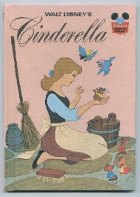by Katie Flanagan
 The other day I came across a relic from my childhood: a picture book version of the Disney movie Cinderella. This was my favorite movie as a preschooler, and I had several picture books retelling it. Since I was a book lover from the day I was born, you’d think I would have adored those versions of my favorite movie. The truth is I shunned them. They were stiff and boring compared to the movie. I remember flipping through them once or twice, and then I put them on my shelf as decorations to my Barbie dolls and Cinderella clock and didn’t think much more of them.
The other day I came across a relic from my childhood: a picture book version of the Disney movie Cinderella. This was my favorite movie as a preschooler, and I had several picture books retelling it. Since I was a book lover from the day I was born, you’d think I would have adored those versions of my favorite movie. The truth is I shunned them. They were stiff and boring compared to the movie. I remember flipping through them once or twice, and then I put them on my shelf as decorations to my Barbie dolls and Cinderella clock and didn’t think much more of them.
Picking the book up as an adult, I remembered how disappointing it had been in comparison to the movie. I wondered what I had so hated about it as a child. Was it simply that the picture book lacked the charming Disney songs of the movie? But that couldn’t be since I have fond memories of other picture books. So what was it that made me cast this one aside?
Reading the book again, it was clear to me what the problem was. The book oversimplified the plot and the characters: it summarized the story instead of telling it. For example, one of the scenes in the book reads:
“‘CINDERELLA’ called the stepmother. Cinderella went downstairs. ‘I want you to clean the floor and wash the windows and dust the drapes,’ said the stepmother.”
The scene in the movie goes much differently: after the mice have managed to get into Drusilla and Anastasia’s breakfasts, the stepmother calls Cinderella in for a talk. The bedroom is dark and sinister, and the cat, Lucifer, grins as he anticipates Cinderella’s punishment. When Cinderella tries to apologize, her stepmother cuts her off, and then the stepmother barks commands at Cinderella in between smiles any five-year-old can identify as false and malicious. Not only is Cinderella told to clean the floor and dust the drapes, but she is ordered around in a scene that establishes Cinderella’s relationship with her stepmother, a scene that establishes the stepmother as the villain, and a scene that just plain engages the watcher’s emotions.
When the picture book reduces the scene to a mere order that occupies Cinderella’s time until the ball, it oversimplifies the plot and the character questions. No longer is the story as much about Cinderella overcoming her stepmother as it is about her falling in love. No longer do we get to see Cinderella’s relationship with her stepmother unfold beat by beat. In the picture book, instead of being emotionally engaged in each scene, we are merely told what happened.
This is not the only place in the book where complexity is lost in oversimplification. The vibrant supporting characters of the King and the Grand Duke, the intricate relationships between the animals, and other details like the absurd awkwardness of Drusilla and Anastasia—details that make the movie a rich story—are all sacrificed for the sake of space and simplicity.
Of course, we cannot be shown everything, despite the platitude “show, don’t tell.” In fact, there are times when telling is preferred to explicitly shown scenes. In the beginning of Cinderella, we are very simply told how she ended up in the attic: her mother died, her father remarried a “cold, cruel, and bitterly jealous” woman, and once he died, Cinderella was “abused, humiliated, and finally forced to become a servant in her house.” All this takes no more than two minutes of the movie, yet we understand the emotions set up without feeling gypped. What is important is the purpose of the scene: we only need to learn what is necessary to get to the story’s emotional starting point. Later on, the purpose of the scenes is to engage the reader in the story, and because of that the meat of the plot and character development cannot be simply told.
The medium of the story dictates pacing to a degree, but no matter whether it is flash fiction or an epic novel, the emotion of the scene cannot be skipped over: that is where literature’s truth survives, and without it, your story is merely a transcript of a movie that told it better.
 Katie Flanagan is a fiction major at Northwestern University (outside of Chicago), an aspiring novelist, and an editor with Booktrope. She also read for Pink Fish Press and Andrea Hurst and Associates, and collaborates on the AUTHORNOMICS Interview series at http://www.andreahurst.com/authornomics-interview-series/. You can contact her at [email protected], at www.facebook.com/kgflanagan, or on Twitter at K_Flanagan.
Katie Flanagan is a fiction major at Northwestern University (outside of Chicago), an aspiring novelist, and an editor with Booktrope. She also read for Pink Fish Press and Andrea Hurst and Associates, and collaborates on the AUTHORNOMICS Interview series at http://www.andreahurst.com/authornomics-interview-series/. You can contact her at [email protected], at www.facebook.com/kgflanagan, or on Twitter at K_Flanagan.


